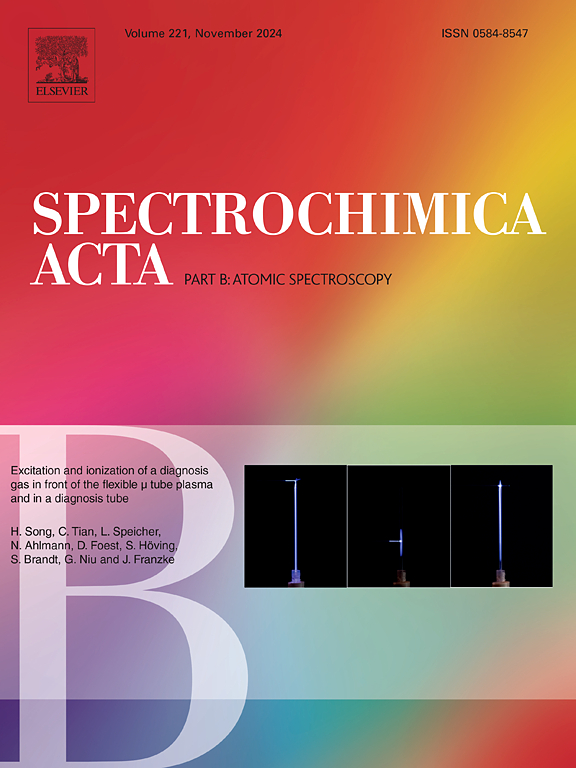Novel insights into solute non-uniformity in liquid-solid LIBS detection: Minimal impact on quantitative accuracy
IF 3.2
2区 化学
Q1 SPECTROSCOPY
引用次数: 0
Abstract
Accurate detection of heavy metals is crucial for ensuring water safety. However, the impact of sample preparation non-uniformity and different scanning strategies on liquid-solid Laser-induced Breakdown Spectroscopy (LIBS) detection has not been fully explored. This study comprehensively analyzes how various solute distribution characteristics, such as solute area, shape, and uniformity, as well as different scanning strategies, impact spectral stability and quantitative accuracy. The analysis was conducted through theoretical modeling, simulations, and experimental validation. Experimental results revealed that for nine samples with same concentrations but varying morphologies, the average spectral intensity fluctuation was only 2.74 %. The findings show that solute non-uniformity has a minimal effect on spectral intensity, offering valuable insights into the actual impact of solute distribution. Among the scanning strategies evaluated, namely full coverage scanning, solute region scanning, and internal matrix array scanning, the solute region scanning strategy demonstrated superior performance. Evaluated using cadmium (Cd), manganese (Mn), and chromium (Cr), this method achieved an average value of 0.992 and a detection limit (LOD) of 56.41 μg/L, representing a 43.40 % reduction in LOD compared to full coverage scanning. These results highlight the significance of optimizing scanning strategies over focusing solely on uniform solute distribution, paving the way for more effective and practical applications of LIBS in water quality monitoring.

求助全文
约1分钟内获得全文
求助全文
来源期刊
CiteScore
6.10
自引率
12.10%
发文量
173
审稿时长
81 days
期刊介绍:
Spectrochimica Acta Part B: Atomic Spectroscopy, is intended for the rapid publication of both original work and reviews in the following fields:
Atomic Emission (AES), Atomic Absorption (AAS) and Atomic Fluorescence (AFS) spectroscopy;
Mass Spectrometry (MS) for inorganic analysis covering Spark Source (SS-MS), Inductively Coupled Plasma (ICP-MS), Glow Discharge (GD-MS), and Secondary Ion Mass Spectrometry (SIMS).
Laser induced atomic spectroscopy for inorganic analysis, including non-linear optical laser spectroscopy, covering Laser Enhanced Ionization (LEI), Laser Induced Fluorescence (LIF), Resonance Ionization Spectroscopy (RIS) and Resonance Ionization Mass Spectrometry (RIMS); Laser Induced Breakdown Spectroscopy (LIBS); Cavity Ringdown Spectroscopy (CRDS), Laser Ablation Inductively Coupled Plasma Atomic Emission Spectroscopy (LA-ICP-AES) and Laser Ablation Inductively Coupled Plasma Mass Spectrometry (LA-ICP-MS).
X-ray spectrometry, X-ray Optics and Microanalysis, including X-ray fluorescence spectrometry (XRF) and related techniques, in particular Total-reflection X-ray Fluorescence Spectrometry (TXRF), and Synchrotron Radiation-excited Total reflection XRF (SR-TXRF).
Manuscripts dealing with (i) fundamentals, (ii) methodology development, (iii)instrumentation, and (iv) applications, can be submitted for publication.

 求助内容:
求助内容: 应助结果提醒方式:
应助结果提醒方式:


